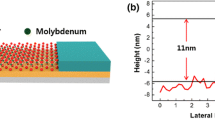Abstract
Layered transition metal dichalcogenides (TMDs) display a wide range of unique electronic properties and are potentially important for electronic device applications. Much interest in these materials led to in-depth research on the device properties of TMDs such as MoS2. Unlike graphene, this material has a relatively large band gap (1.3–1.9 eV) and exhibits stable on/off switching as a transistor. TMD materials represent ideal channel materials for device scalability as their few-atom-thick layers devoid of dangling bonds will be robust against short-channel effects for ultrathin channeled transistors. As MoS2 devices are scaled down, robust high-field operation is essential for the development of reliable electronic systems. In this work, we explore the high-field characteristics of MoS2-based transistors and investigate their relationship to the contact resistance. Importantly, we show that high-voltage characteristics, current drives, and breakdown voltages of MoS2 transistors can be significantly improved through the use of a metal-insulator-semiconductor contact at the metal/MoS2 interface.
Similar content being viewed by others
References
F. Schwierz, Nat. Nanotechnol. 5, 487 (2010).
K. F. Mak et al., Phys. Rev. Lett. 105, 136805 (2010).
Y. Yoon, K. Ganapathi and S. Salahuddin, Nano Lett. 11, 3768 (2011).
N. Kaushik et al., Appl. Phys. Lett. 105, 113505 (2014).
P. Avouris, Z. Chen and V. Perebeinos, in Nanoscience And Technology: A Collection of Reviews from Nature Journals (World Scientific, 2010).
E. Pop, Nanotechnology 19, 295202 (2008).
H. Ilatikhameneh et al., IEEE Trans. Nanotechnol. 17, 293 (2018).
E. Pop, S. Sinha and K. E. Goodson, Proc. IEEE 94, 1587 (2006).
G-S. Kim et al., ACS Nano 12, 6292 (2018).
J. Wang et al., Adv. Mater. 28, 8302 (2016).
J. Zhang et al., ACS Nano 8, 6024 (2014).
B. Radisavljevic et al., Nat. Nanotechnol. 6, 147 (2011).
S. Das, H-Y. Chen, A. V. Penumatcha and J. Appenzeller, Nano Lett. 13, 100 (2012).
G-S. Kim et al., ACS Nano 12, 6292 (2018).
R. Kappera et al., Nat. Mater. 13, 1128 (2014).
H. Fang et al., Nano Lett. 12, 3788 (2012).
H. Fang et al., Nano Lett. 13, 1991 (2013).
L. Hung, C. W. Tang and M. G. Mason, Appl. Phys. Lett. 70, 152 (1997).
R. Jackson et al., Adv. Funct. Mater. 18, 2548 (2008).
H. Liu, Y. Liu, D. Zhu and J. Mater. Chem. 21, 3335 (2011).
L. Lin, J. Robertson and S. Clark, Microelectron. Eng. 88, 1461 (2011).
T. Nishimura, K. Kita and A. Toriumi, Appl. Phys. Express. 1, 051406 (2008).
J. Hu, K. C. Saraswat and H-S. P. Wong, J. Appl. Phys. 107, 063712 (2010).
J. Hu et al., Appl. Phys. Lett. 99, 252104 (2011).
X. Cui et al., Nano Lett. 17, 4781 (2017).
V. Heine, Phys. Rev. 138, A1689 (1965).
J. Tersoff, Phys. Rev. Lett. 52, 465 (1984).
R. T. Tung, Phys. Rev. B 64, 205310 (2001).
S-L. Li et al. Nano Lett. 13, 3546 (2013).
S-L. Li et al., ACS Nano 8, 12836 (2014).
C. Lee et al., ACS Nano 4, 2695 (2010).
D. Lembke and A. Kis, ACS Nano 6, 10070 (2012).
P. L. Hower and V. K. Reddi, IEEE Trans. Electron Devices 17, 320 (1970).
T. Georgiou et al., Nat. Nanotechnol. 8, 100 (2013).
Acknowledgments
This work was supported by grants from Kyung Hee University in 2016 (KHU-20160609) and by National Research Foundation of Korea (NRF) grants funded by the Korea government (No. 2017M1A7A1A01016262) and (No. 2017R1C1B2012227). This work was also supported by the Technology Innovation Program (or Industrial Strategic Technology Development Program (No. 1008 5646, Memristor Fault-Aware Neuromorphic System for 3D Memristor array) funded by the Ministry of Trade, Industry & Energy (MOTIE, Korea). This research was also supported by the Basic Science Research Program through the NRF funded by the Ministry of Education (grant No. 2018R1A6A1A03025708, Study on integrated multifunctional sensor platforms based on autonomous energy).
Author information
Authors and Affiliations
Corresponding authors
Rights and permissions
About this article
Cite this article
Lee, S., Kim, Lw. Effect of Contact Resistance on the High-Field Characteristics of MoS2 Transistors. J. Korean Phys. Soc. 75, 471–475 (2019). https://doi.org/10.3938/jkps.75.471
Received:
Revised:
Accepted:
Published:
Issue Date:
DOI: https://doi.org/10.3938/jkps.75.471




